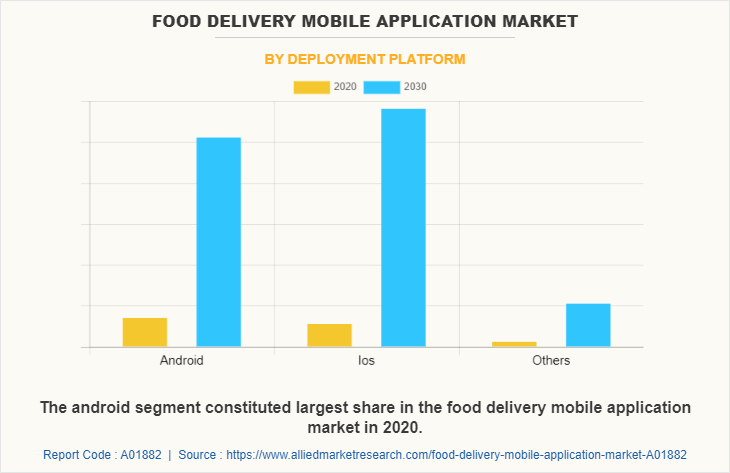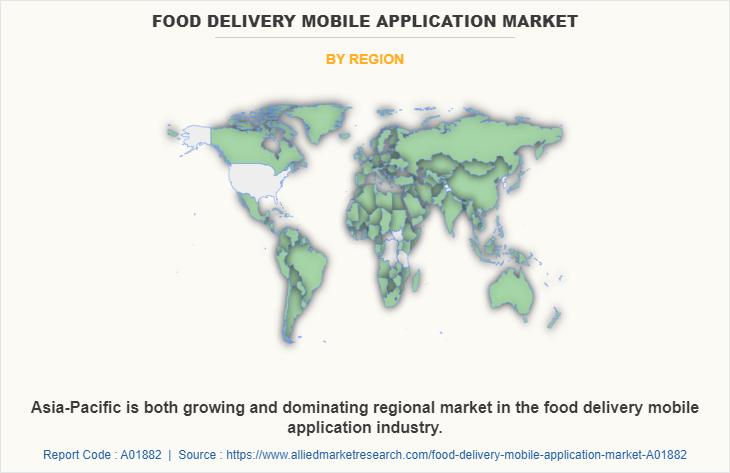Food Delivery Mobile Application Market Insights:
The global food delivery mobile application market was valued at USD 6,752.32 million in 2020, and is projected to reach USD 62,836.97 million by 2030, growing at a CAGR of 25% from 2021 to 2030.
High internet penetration and increase in adoption of smartphones boost the growth of the global market. In addition, changing lifestyle in developing countries positively impacts the growth of the market. However, lack of high-speed connectivity in developing and underdeveloped regions and uncertainty of enterprises in developing their own applications hamper the food delivery mobile application market growth. On the contrary, rise in investment on digitalization and increase in alliances and collaborations of various restaurants with the application developers are expected to offer remunerative opportunities for expansion of the market during the forecast period.

Food delivery mobile application is a novel platform for restaurants, franchisees, and other food-selling proprietors to offer a convenient way of providing consumers with a wide range of options through a single online mobile portal. The business of delivering restaurant meals at consumers’ place has gone through a lot of improvement from telephone-based ordering system to takeout counters, and now websites and mobile applications. The food delivery mobile application offers access to single or multiple restaurants through a single online portal, where consumers can compare menus, prices, offers, and reviews given by experienced consumers.
Furthermore, the mobile applications are being developed for food delivery providers who act as a middleman between a restaurant and a consumer. These food delivery mobile applications offer various advantages, including cost savings, high profit margins, high return on investments (ROI), high customer retention, and global reach. This has allowed key market players to increase their market presence in local as well as international markets with high growth perspectives.
Segment Review:
The food delivery mobile application market is segmented on the basis of deployment platform, end user, and region. On the basis of deployment platform, the market is segmented into Android, iOS, and others. The end-user segment, the market is bifurcated into food delivery market place and restaurants & others. On the basis of geography, the market is analyzed across North America, Europe, Asia-Pacific, and LAMEA.

In terms of deployment platform, the android segment holds the largest food delivery mobile application market share, owing to large number of android users as compared to another type of operating system. However, the iOS segment is expected to grow at the highest rate during the forecast period, owing to global digitization, cross-device development, accessible designer tools, and monetization (viability of paid app downloads) are expected to fuel the market growth of the food delivery mobile application market based on iOS platform.

Region-wise, the food delivery mobile application market size was dominated by Asia-Pacific in 2020, and is expected to witness significant growth during the forecast period, owing to countries, such as China, India, Japan, and Australia. Many global and domestic food service players, including Zomato, Foodpanda, Waimai Baidu, and others operate in the Asia-Pacific market owing to increase in penetration of smartphones in the region which has resulted in improved food delivery models.
The key players that operate in the food delivery mobile application industry are Apple Inc., CA, Inc. (Broadcom), Cognizant, Google Inc., IBM Corporation, Mendix, Microsoft Corporation, Red Hat, Inc., SAP SE, and Zoho Corporation Pvt. Ltd.
Top Impacting Factors:
High Internet Penetration
The food delivery mobile application industry is strongly driven by rapid increase in Internet penetration, especially, in developing countries, such as Brazil, India, China, and others. In recent years, individuals have adopted Internet as a prime medium of communication through various devices, such as smartphones, tablets, and laptops. Internet allows easy access to restaurants or franchises with minimum effort and cost. In addition, the number of online buyers has significantly increased owing to growth in the e-commerce industry, product assortment, and convenience offered by the vendors, and various discounts that are available only on e-platforms. Moreover, network providers offer various offers or plans regarding Internet, which decreases the costs of Internet even more and can easily be made affordable in underdeveloped or developing countries.
Increase in Adoption of Smartphones
Smartphones is one of the highly appreciated mediums of communication, on which food delivery mobile applications are being launched in the market by key vendors. It gives users a platform to install the application and use it to get food delivery services from nearby restaurants, hotels, or franchises. Technological advancements in smartphones and their declining prices have increased their demand globally. This has urged mobile application developers and restaurant owners to collaborate and launch food delivery apps on various platforms including iOS, Windows, and Android.
Key Benefits for Stakeholders:
- This report provides a quantitative analysis of the market segments, current trends, estimations, and dynamics of the food delivery mobile application market analysis from 2020 to 2030 to identify the prevailing food delivery mobile application market opportunities.
- The food delivery mobile application market research is offered along with information related to key drivers, restraints, and opportunities.
- Porter's five forces analysis highlights the potency of buyers and suppliers to enable stakeholders make profit-oriented business decisions and strengthen their supplier-buyer network.
- In-depth analysis of the food delivery mobile application market forecast segmentation assists to determine the prevailing market opportunities.
- Major countries in each region are mapped according to their revenue contribution to the global market.
- Market player positioning facilitates benchmarking and provides a clear understanding of the present position of the market players.
- The report includes the analysis of the regional as well as global food delivery mobile application market trends, key players, market segments, application areas, and market growth strategies.
Food Delivery Mobile Application Market Report Highlights
| Aspects | Details |
| By Deployment Platform |
|
| By End User |
|
| By Region |
|
| Key Market Players | Mendix, Cognizant, SAP SE, Red Hat, Inc., CA, Inc. (Broadcom), Zoho Corporation Pvt. Ltd., Apple Inc., Microsoft Corporation, Google Inc., IBM Corporation |
Analyst Review
Online food ordering is a growing trend, especially in urban areas and on college campuses that allows people to order food from restaurants featuring interactive menus, by using their smartphones. In many cases, any internet capable device that can handle complicated web pages can be used to make orders, though a lot of people rely on a desktop or laptop computer for this. The second definition of online food ordering is ‘ordering from grocery stores to stock the kitchen, instead of placing one time orders with a restaurant’.
Key providers of the market, such as Apple Inc., Google LLC, and Microsoft Corporation account for a significant share in the market. With the larger requirement for food delivery mobile application, various companies are partnering to increase the food delivery mobile application capabilities. For instance, in January 2019, SAP SE collaborated with Hero SE, a global food delivery service. It developed rapidly growing businesses and it helps to look for an enterprise-grade ERP product. The company eventually decided on SAP S/4HANA for the core of its intelligent enterprise.
Furthermore, key players are launching new products to increase their market penetration. For instance, ITC’s Hotel Group has launched a one-stop app that will let guests access services such as room and restaurant reservations, food delivery takeaway, and loyalty membership essentials across ITC Hotels, Welcomhotels, and select Fortune Hotels. The ITC Hotels App enables people to book their stay at over 55 hotels. The app enables food delivery and takeaway in 14 cities, such as Delhi NCR, Mumbai, Kolkata, Chennai, Bengaluru, Hyderabad, Goa, Agra, Jaipur, Vadodara, Amritsar, Coimbatore, and Bhubaneswar and Guntur are coming soon. People can order through a common cart where they can place an order from multiple menus in one order. Table reservations at over 75 restaurants at ITC Hotels & Welcomhotels are also accepted on the app.
Rise in internet penetration and surge in adoption of smartphones across the globe.
Collective Market size of Food Delivery mobile application market by deployment platform is anticipated to reach USD 62,836.97 million by 2030
The major players operating in the industry are Apple Inc., CA, Inc. (Broadcom), Cognizant, Google Inc., IBM Corporation, Mendix, Microsoft Corporation, Red Hat, Inc., SAP SE, and Zoho Corporation Pvt. Ltd
The android and food delivery market place is projected to increase the demand for food delivery mobile application market in 2020
The COVID-19 pandemic have a significant impact on the food delivery mobile application due to growing lockdown in majority of the countries.
Loading Table Of Content...



